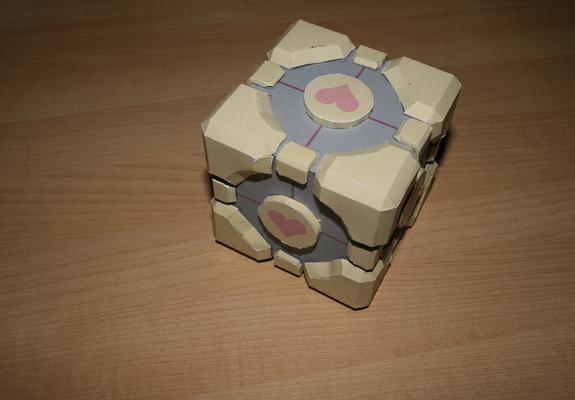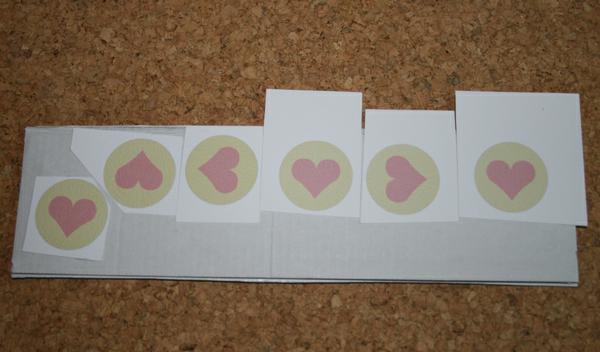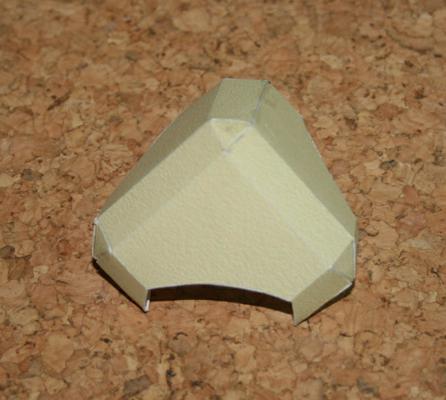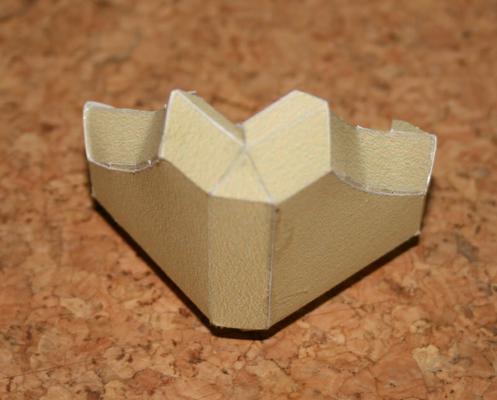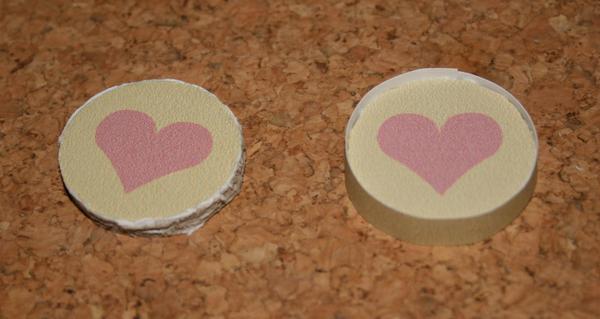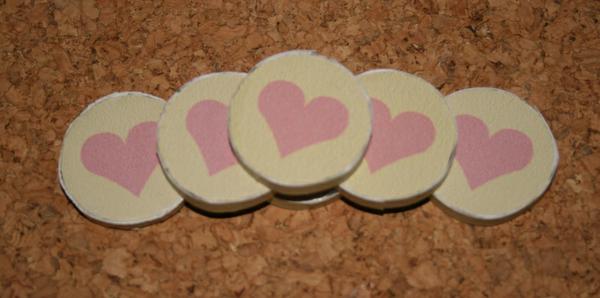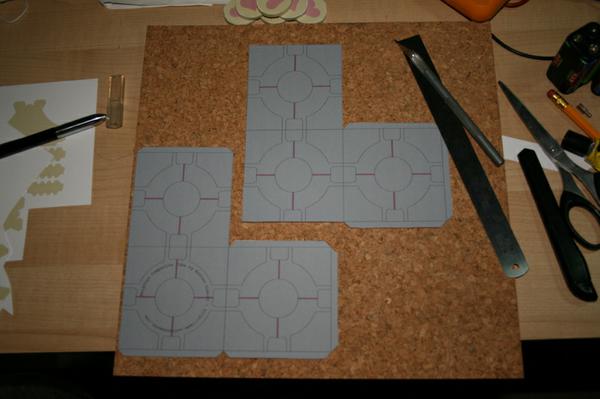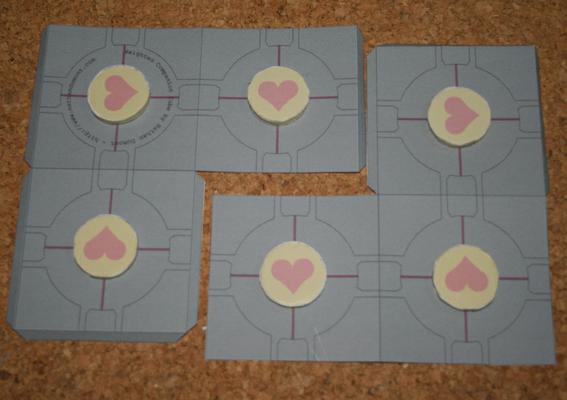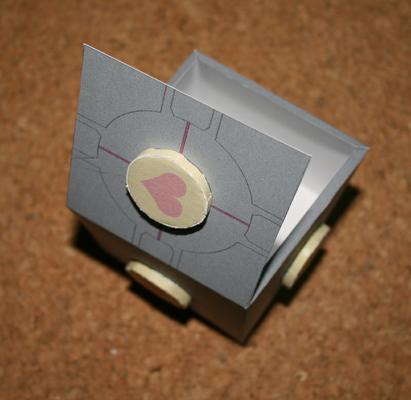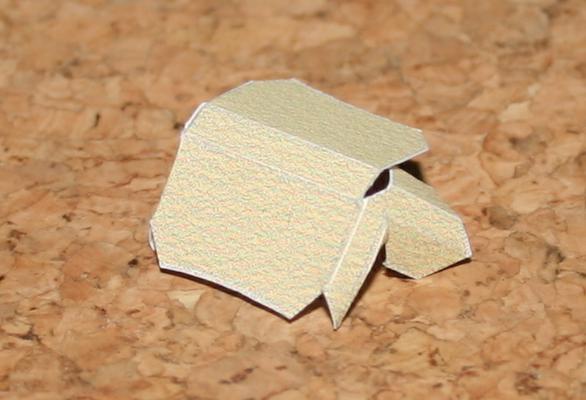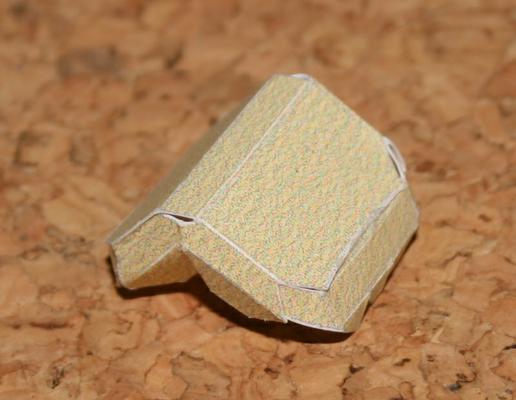Papercraft Weighted Companion Cube Model
Last updated: Oct. 19, 2007, 4:14 p.m.
During a fairly dull lecture earlier this week I came up with the mad idea to create a cardboard model of the weighted companion cube from "Portal" a new game from Valve. The companion cube has become quite a cult thing so I'm guessing there may be more people out there that would like to have a little cardboard companion cube sitting on their desk!
What do I need
- 3 pieces of A4 card/thick paper.
- A bit of thicker card just to use as a spacer, anything will do.
- A colour printer of some sort.
- Scissors and glue.
- Plenty of time (the prototype took 10+ hours to make)
How to make it
- Download the pdf file (see the attachments at the end of this post.)
- Print out all three pages of the file (yes the last two pages are the same but you need that many parts). Preferably on some thin card/heavy paper rather than standard printer paper.
- Follow the assembly instructions below.
- Enjoy your cube!
Assembly instructions
The first thing I did was get some thicker card from some packaging and stuck down the circles that will go on the centre of each face of the cube to this thicker card. I used 2 layers, I reckon this wants to be somewhere between 2 and 5 mm thick. So stick those down without cutting them out properly for now and leave them on the side for the glue to dry while you do something else.
Next, whilst the glue is setting, cut out a full set of corner parts (see the picture to see which ones they are.) Carefully score along the faint grey lines with a knife and ruler, then fold all the parts gently into shape. All the corners in this model are convex i.e. the print is on the outside of the fold. Glue the long tab under the side of the long edge to make up the corner. Once this is firmly stuck carefully stick the small triangles in, both in the centre and on the ends. Once you've done this you should have the piece shown in Stage 3.
The next bit is more tricky, you should have three small sections with many tabs around them, these fill in the gaps in the corner you just made. They are meant to curve along the line of the circular design on the side of the cube. You need to glue these in along the top and sides all at once to the corner piece you just made up. It's a good idea to make sure that the glue has set on the corner first. Once you've done this you should have a complete corner part, see Stage 4. I suggest you leave this alone for a bit until the glue has hardened a bit.
Take a look at the circles again now and see if they're ready. If not you can make up another corner or two, you need 8 in total. Assuming you're ready to carry on with the circles, cut them out of the card, I used a craft knife since scissors would have crushed the corrugations of the thicker card I had padded them with. How you cut them out will depend on what card you chose. Once you've cut it out it should look like the one on the left in Stage 5, now you get to find out what those random blocks of colour you printed were. They weren't just there to fill up space and waste ink, you need to glue these onto the edge of the spacer card to hide the edges so that they look like the one on the right in Stage 5. They're designed to be too wide rather than too thin, so if there's some overlap just trim it off once the glue has dried. I would say that it's better to line them up with the front face and trim excess from the back, although I know this isn't what I did on the first one. There should also be some overlap, that's fine, it'll work best if you glue that down and lap it over, don't try to cut the excess off. Once all of the circles are ready, you should have 6 of them like in Stage 6.
The next step is to make up the grey box, but before I did glue that up, I stuck the circles down while there was something solid behind the card. So, cut out the grey card net of the box from the first page you printed, score the folds carefully and you should have the parts shown in Stage 7. Next I stuck on the circles with those pretty pink hearts on (Stage 8). I'm not sure which way they're meant to go, I didn't research that very thoroughly, you can if you want. Leave these to dry a bit before you do any more, because the next stage is to stick the box together.
If you look at the two 'L' shaped parts of the box you will notice that the tabs on them aren't the same. if you spin them so that they're 180 degrees rotated from one another you should find that there is a tab and a blank space meeting in the middle column, and there's one square out to the right in the second row and one to the left in the third. Glue that tab and carefully fold the box up and glue the tabs. BUT WAIT!!! Don't glue the top down yet, it'll be a lot easier to stick those corners on while you can still stick your hands inside the thing. So you should now be at Stage 9.
Ok, so you remember that corner you made, let's stick it on and start to get a feel for how awesome this model is going to be. Make sure all the tabs on the inside are folded in and put a bit of glue on each. Now, put one hand in the box and gently push the corner on, it should fit just up to the black line on the box. Make sure you pushed it down well, but don't crush the card. Leave it alone to dry again, and then admire your work (Stage 10). You've got another three corners to do now, so what are you waiting for?
Right, now you thought that those curved bits on the corners were fiddly didn't you? Well, the next bit is even fiddlier believe it or not. The little bits that go between the corners are the next thing to do, and they've got a tiny little bit of curved piece on the front. These pieces also have the only faint grey line that needs to be cut in them, there's a diagonal between two tabs that you'll need to cut on each side. So cut out one set of these parts and fold it up like in Stage 11. Glue this part up to make the 90 degree corner part and then let it dry while you cut out the two ends for it. These are the smallest part in the model, again just cut out and fold along the lines. You need to glue these into the gaps at each end of the bit you just folded up so that it looks like the one in Stage 12.
Once you've got that done you can stick it onto the cube, again it should line up with the outline printed in black on the box. You need to make up another 7 of these and stick them on before you're ready to glue the lid down. Once the four corners are done and the 8 middley bits are finished you can't do any more without sticking the lid down. Ok, so go ahead and stick the lid down, you might want to weight it with something or reinforce it inside before you do glue the lid on, I was happy with mine and it seemed quite strong so I didn't bother. Once the lid is glued down it should look like Stage 13 (kind of bald!)
Carry on making up corners and middle bits and stick the last four of each in place around the top and you're done! That's your very own weighted companion cube in a handy desk sized form.
Well, hopefully that's explained it. Building it seemed fairly obvious to me, I don't know if that's because it was or because I designed the model, so I hope you haven't been too bored by this, and if you were, why did you read it? Any way, as usual any questions you have can be emailed to me hairymnstr@gmail.com or you can register to leave a comment on this page.
Design
Just for those who wondered, I drew the model in Inkscape, a free open-source vector drawing program, and you can see in the picture that it went through some development before it got to the model here.
| Attachment | Last Update | Size |
|---|---|---|
| Printable parts | Nov. 2, 2014, 10:01 p.m. | 1.6 MB |
Comments
Posting comments is not currently possible. If you want to discuss this article you can reach me on twitter or via email.
